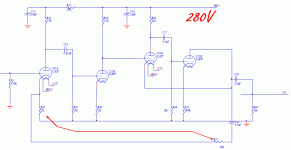Hello,
I built a DIY 12at7 preamplifier.
The tubes run at 12v.
The issu is that the amount of gain is enormous.
The preamp has a volume control on the input but if I run it to a power amp, the gain is such that even the relay cliking on the preamp blows like a bomb (the power amp has no volume control)
In order to use it, I had no choice but to put a dale volume controls between the preamp and the power amp.
This been said, I was wondering if going from 12v to maybe 7 or 8 would reduce the gain or am I condemned to insert a dale between the premp and the power amp?
Thanks
I built a DIY 12at7 preamplifier.
The tubes run at 12v.
The issu is that the amount of gain is enormous.
The preamp has a volume control on the input but if I run it to a power amp, the gain is such that even the relay cliking on the preamp blows like a bomb (the power amp has no volume control)
In order to use it, I had no choice but to put a dale volume controls between the preamp and the power amp.
This been said, I was wondering if going from 12v to maybe 7 or 8 would reduce the gain or am I condemned to insert a dale between the premp and the power amp?
Thanks
The issue is that the amount of gain is enormous.
You didn't look at the data sheet?
jeff
You didn't look at the data sheet?
jeff
well it is a Chinese DIY, hey don't say much.
On a 300B amp it was ok but on a solid state the gain blows every thing.
I have the schematic in pdf, how can I link it?
Click go advanced then click the paperclip/ choose file/ upload
Nevermind I see you got it
Last edited:
Probably you don't need gain at all for that solid state amplifier ... so the obvious solution would be to build/buy just a tube cathode follower / buffer .
Or maybe use a lot of negative feedback , much lower value for R47 , 48 . If you replace it with a pot you could adjust for the gain you need .
Or maybe use a lot of negative feedback , much lower value for R47 , 48 . If you replace it with a pot you could adjust for the gain you need .
Last edited:
you could tame it by changing the value of R47, 48 to a lower value. Gives more negative feedback, yielding an even more linear amplifier, albeit at lower gain.
Try 6.8 kΩ, for each. ¼ watt is just fine.
⋅-⋅-⋅ Just saying, ⋅-⋅-⋅
⋅-=≡ GoatGuy ✓ ≡=-⋅
PS...M. Depanatoru had a good idea of putting a 25 kΩ potentiometer (in series with a 2.2 kΩ resistor for safety) in place of the 22 kΩ resistors. This gives it variable gain, and variable linearity. If mounted on the front or back panel, it allows rapid adjustment to 'see'. Eventually you will find a setting you like. Then turn the whole thing OFF and replace with a similar value standard resistor if you like. Obviously, one could even install a front panel switch to switch in either the pot or the fixed resistor. Bells and whistles, yah!!!
Try 6.8 kΩ, for each. ¼ watt is just fine.
⋅-⋅-⋅ Just saying, ⋅-⋅-⋅
⋅-=≡ GoatGuy ✓ ≡=-⋅
PS...M. Depanatoru had a good idea of putting a 25 kΩ potentiometer (in series with a 2.2 kΩ resistor for safety) in place of the 22 kΩ resistors. This gives it variable gain, and variable linearity. If mounted on the front or back panel, it allows rapid adjustment to 'see'. Eventually you will find a setting you like. Then turn the whole thing OFF and replace with a similar value standard resistor if you like. Obviously, one could even install a front panel switch to switch in either the pot or the fixed resistor. Bells and whistles, yah!!!
Last edited:
While the smart guys were answering off the top of their heads I came to the same conclusion simulating it. I used 10K for the feedback resistor but I did see it was already a bit suspect at uhf with the 22k. I would be prepared to bypass the feedback resistors with a cap, something on the order of 100pF seemed to work in the virtual world. 10K feedback resistor gets 15dB gain OAL. All in all though it looks like a low distortion circuit.
Yes, according to the tests of a friend who is an electronic engineer, it is in deed very low distortion
The plate supply voltage is 280V (not 12V).
The gain is right-on "12" determined by two resistors (simulation not needed). Letting gain vary with supply voltage is poor design, and this one avoids that issue.
Old-school hi-fi might have need for gain of 10 or so between phono preamp and insensitive power amp. Many modern systems with DACs should NOT have this much excess gain.
The gain is right-on "12" determined by two resistors (simulation not needed). Letting gain vary with supply voltage is poor design, and this one avoids that issue.
Old-school hi-fi might have need for gain of 10 or so between phono preamp and insensitive power amp. Many modern systems with DACs should NOT have this much excess gain.
Attachments
- Home
- Amplifiers
- Tubes / Valves
- 12at7 voltage and gain
